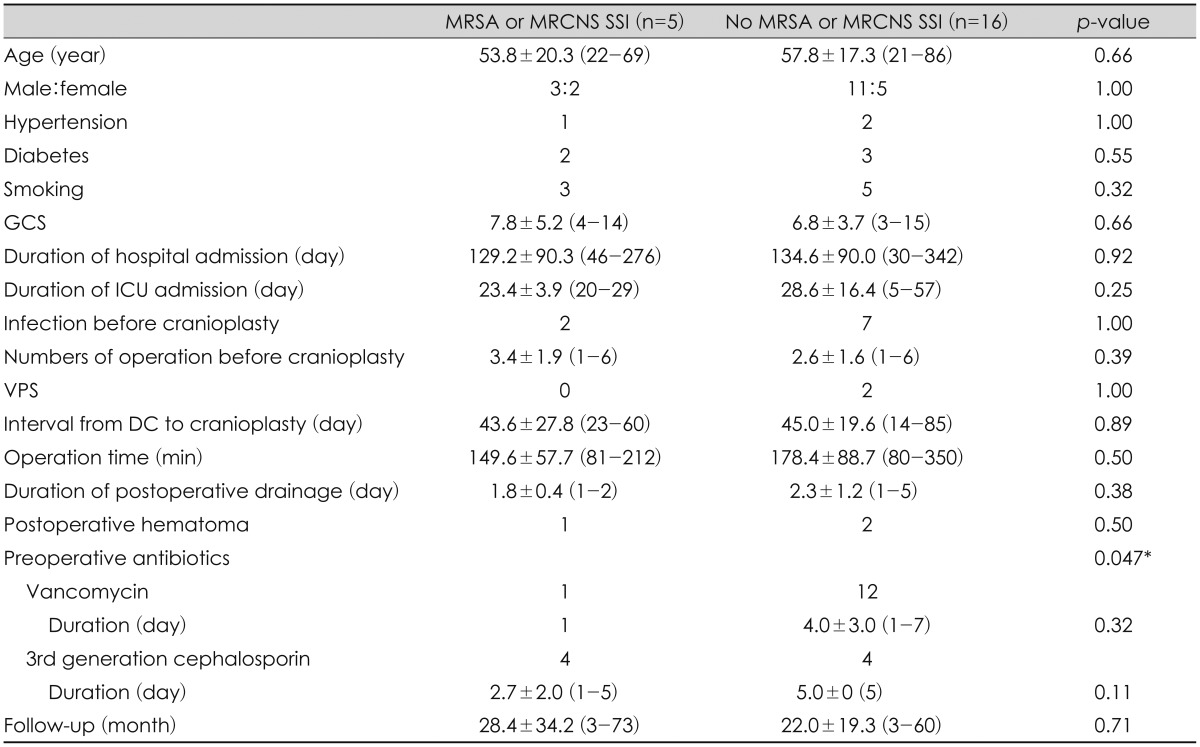1. Abad CL, Pulia MS, Safdar N. Does the nose know? An update on MRSA decolonization strategies. Curr Infect Dis Rep. 2013; 15:455–464. PMID:
24150839.

2. Abi-Haidar Y, Gupta K, Strymish J, Williams SA, Itani KM. Factors associated with post-operative conversion to methicillin-resistant Staphylococcus aureus positivity or infection in initially MRSA-negative patients. Surg Infect (Larchmt). 2011; 12:435–442. PMID:
22142319.
3. Akins PT, Belko J, Banerjee A, Guppy K, Herbert D, Slipchenko T, et al. Perioperative management of neurosurgical patients with methicillin-resistant Staphylococcus aureus. J Neurosurg. 2010; 112:354–361. PMID:
19522572.

4. American Academy of Orthopaedic Surgeons Patient Safety Committee. Evans RP. Surgical site infection prevention and control: an emerging paradigm. J Bone Joint Surg Am. 2009; 91(Suppl 6):2–9. PMID:
19884406.

5. Blomstedt GC, Kyttä J. Results of a randomized trial of vancomycin prophylaxis in craniotomy. J Neurosurg. 1988; 69:216–220. PMID:
3292719.

6. Bratzler DW, Dellinger EP, Olsen KM, Perl TM, Auwaerter PG, Bolon MK, et al. Clinical practice guidelines for antimicrobial prophylaxis in surgery. Am J Health Syst Pharm. 2013; 70:195–283. PMID:
23327981.

7. Chen AF, Wessel CB, Rao N. Staphylococcus aureus screening and decolonization in orthopaedic surgery and reduction of surgical site infections. Clin Orthop Relat Res. 2013; 471:2383–2399. PMID:
23463284.

8. Ercis S, Sancak B, Hasçelik G. A comparison of PCR detection of mecA with oxacillin disk susceptibility testing in different media and sceptor automated system for both Staphylococcus aureus and coagulase-negative staphylococci isolates. Indian J Med Microbiol. 2008; 26:21–24. PMID:
18227592.

9. Forster AJ, Oake N, Roth V, Suh KN, Majewski J, Leeder C, et al. Patient-level factors associated with methicillin-resistant Staphylococcus aureus carriage at hospital admission: a systematic review. Am J Infect Control. 2013; 41:214–220. PMID:
22999773.

10. Goyal N, Miller A, Tripathi M, Parvizi J. Methicillin-resistant Staphylococcus aureus (MRSA): colonisation and pre-operative screening. Bone Joint J. 2013; 95-B:4–9. PMID:
23307666.
11. Hammond CJ, Gill J, Peto TE, Cadoux-Hudson TA, Bowler IC. Investigation of prevalence of MRSA in referrals to neurosurgery: implications for antibiotic prophylaxis. Br J Neurosurg. 2002; 16:550–554. PMID:
12617235.
12. Harbarth S, Fankhauser C, Schrenzel J, Christenson J, Gervaz P, Bandiera-Clerc C, et al. Universal screening for methicillin-resistant Staphylococcus aureus at hospital admission and nosocomial infection in surgical patients. JAMA. 2008; 299:1149–1157. PMID:
18334690.
13. Harbarth S, Sax H, Fankhauser-Rodriguez C, Schrenzel J, Agostinho A, Pittet D. Evaluating the probability of previously unknown carriage of MRSA at hospital admission. Am J Med. 2006; 119:275.e15–275.e23. PMID:
16490475.

14. Honda H, Krauss MJ, Coopersmith CM, Kollef MH, Richmond AM, Fraser VJ, et al. Staphylococcus aureus nasal colonization and subsequent infection in intensive care unit patients: does methicillin resistance matter? Infect Control Hosp Epidemiol. 2010; 31:584–591. PMID:
20426656.
15. Im SH, Jang DK, Han YM, Kim JT, Chung DS, Park YS. Long-term incidence and predicting factors of cranioplasty infection after decompressive craniectomy. J Korean Neurosurg Soc. 2012; 52:396–403. PMID:
23133731.

16. Jog S, Cunningham R, Cooper S, Wallis M, Marchbank A, Vasco-Knight P, et al. Impact of preoperative screening for meticillin-resistant Staphylococcus aureus by real-time polymerase chain reaction in patients undergoing cardiac surgery. J Hosp Infect. 2008; 69:124–130. PMID:
18387695.

17. Kim DH, Spencer M, Davidson SM, Li L, Shaw JD, Gulczynski D, et al. Institutional prescreening for detection and eradication of methicillin-resistant Staphylococcus aureus in patients undergoing elective orthopaedic surgery. J Bone Joint Surg Am. 2010; 92:1820–1826. PMID:
20610773.

18. Le C, Guppy KH, Axelrod YV, Hawk MW, Silverthorn J, Inacio MC, et al. Lower complication rates for cranioplasty with peri-operative bundle. Clin Neurol Neurosurg. 2014; 120:41–44. PMID:
24731574.

19. Lee CH, Chung YS, Lee SH, Yang HJ, Son YJ. Analysis of the factors influencing bone graft infection after cranioplasty. J Trauma Acute Care Surg. 2012; 73:255–260. PMID:
22743392.

20. Pofahl WE, Ramsey KM, Nobles DL, Cochran MK, Goettler C. Importance of methicillin-resistant Staphylococcus aureus eradication in carriers to prevent postoperative methicillin-resistant Staphylococcus aureus surgical site infection. Am Surg. 2011; 77:27–31. PMID:
21396301.

21. Sundseth J, Sundseth A, Berg-Johnsen J, Sorteberg W, Lindegaard KF. Cranioplasty with autologous cryopreserved bone after decompressive craniectomy: complications and risk factors for developing surgical site infection. Acta Neurochir (Wien). 2014; 156:805–811. discussion 811PMID:
24493001.

22. Tacconelli E, Cataldo MA, Albanese A, Tumbarello M, Arduini E, Spanu T, et al. Vancomycin versus cefazolin prophylaxis for cerebrospinal shunt placement in a hospital with a high prevalence of meticillin-resistant Staphylococcus aureus. J Hosp Infect. 2008; 69:337–344. PMID:
18602187.

23. Tom TS, Kruse MW, Reichman RT. Update: Methicillin-resistant Staphylococcus aureus screening and decolonization in cardiac surgery. Ann Thorac Surg. 2009; 88:695–702. PMID:
19632455.

24. Yadla S, Campbell PG, Chitale R, Maltenfort MG, Jabbour P, Sharan AD. Effect of early surgery, material, and method of flap preservation on cranioplasty infections: a systematic review. Neurosurgery. 2011; 68:1124–1129. discussion 1130PMID:
21242830.

25. Yang SM, Park HK, Cho SJ, Chang JC, Park SQ, Kim RS. The Current Analysis of the Risk Factors for Bone Graft Infection after Cranioplasty. Korean J Neurotrauma. 2013; 9:57–63.






 PDF
PDF ePub
ePub Citation
Citation Print
Print



 XML Download
XML Download